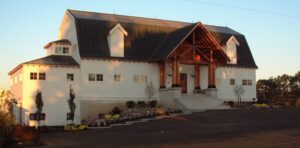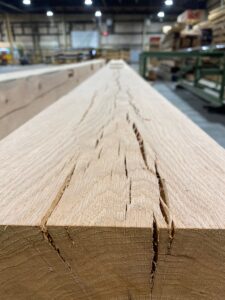The Best Wood Species for Timber Framing: Strength, Beauty, and Tradition
Timber framing is more than just a building technique—it’s a celebration of craftsmanship, natural materials, and architectural heritage. Choosing the right wood species is one of the most important decisions in any timber frame project. It affects everything from structural integrity and durability to aesthetic appeal and cost.
Here’s a breakdown of the top wood species commonly used for timber framing, and what makes each one stand out.
1. Douglas Fir $$
Best for: Structural strength and availability
Douglas fir is one of the most popular choices for timber framing in North America—and for good reason. It’s strong, straight-grained, and widely available. Its high strength-to-weight ratio makes it ideal for large spans and heavy loads.
Pros:
- Excellent strength and stiffness
- Good dimensional stability
- Readily available in large sizes

A barn built with a Douglas Fir frame - Takes finishes well
Cons:
- Prone to surface checking as it dries
- Can be more expensive in certain regions
2. Eastern White Pine $
Best for: Traditional aesthetic and ease of use
For those drawn to the classic New England look, Eastern White Pine is a go-to. It’s lightweight and easy to work with, making it ideal for hand-hewn beams and traditional joinery.
Pros:
- Beautiful light color and grain
- Easy to shape and cut
- Cost-effective
- Stable once dry
Cons:
- Softer and less strong than other species
- More prone to denting or damage
3. Oak (White or Red) $$$
Best for: Historical authenticity and natural durability
Oak has a storied history in timber framing, especially in Europe. White oak, in particular, is prized for its durability and resistance to moisture and pests, making it suitable for exposed or outdoor frames.
Pros:
- Extremely durable
- Rich, attractive grain

Rustic look with the checking of oak - Ideal for long-lasting structures
Cons:
- Heavy and dense (harder to work with)
- Expensive
- Can cause corrosion with metal fasteners (use stainless steel or traditional joinery)
4. Southern Yellow Pine (SYP) $
Best for: Budget-conscious builds with good strength
SYP is a strong, affordable softwood commonly used in the Southeastern U.S. It’s well-suited for structural applications but can be harder to work due to its density and resin content.
Pros:
- Very strong for a softwood
- Affordable and plentiful
- Good nail and screw holding
Cons:
- Can warp or twist if not dried properly
- Resin can gum up tools
5. Western Red Cedar $$$$
Best for: Outdoor or exposed timber frames
Western Red Cedar offers natural resistance to rot and insects, making it perfect for outdoor structures, pavilions, and timber elements exposed to the elements.
Pros:
- Naturally decay-resistant
- Lightweight
- Pleasant aroma and attractive color
Cons:
- Softer and weaker than other framing species
- Premium price
What to Consider When Choosing a Wood Species
- Local availability: Regional species often offer the best value and lowest environmental impact.
- Design loads: Match wood strength to structural needs.
- Moisture content: Green, air-dried, or kiln-dried timbers affect shrinkage and joinery.
- Aesthetic preferences: Grain, color, and aging characteristics matter for exposed frames.
- Budget: Costs can vary significantly by species and source.
Final Thoughts
The “best” wood for your timber frame ultimately depends on your project goals, location, and personal preferences. Whether you value strength, sustainability, historical accuracy, or visual appeal, there’s a wood species that fits your frame.
Want help selecting the right timber for your specific project or region? Reach out or leave a comment—I’d be happy to offer advice based on your needs.
